The Impact of Changes in Anthropogenic Activity Caused by COVID-19 Lockdown on Reducing Nitrogen Dioxide Levels in Thailand Using Nighttime Light Intensity
Abstract
1. Introduction
2. Materials and Methods
2.1. Data Sources and Preparation
2.2. Estimation of Air Pollution Emission and Its Relationship with Anthropogenic Activities
3. Results
3.1. NO2 Level and NTL Intensity Change in Thailand
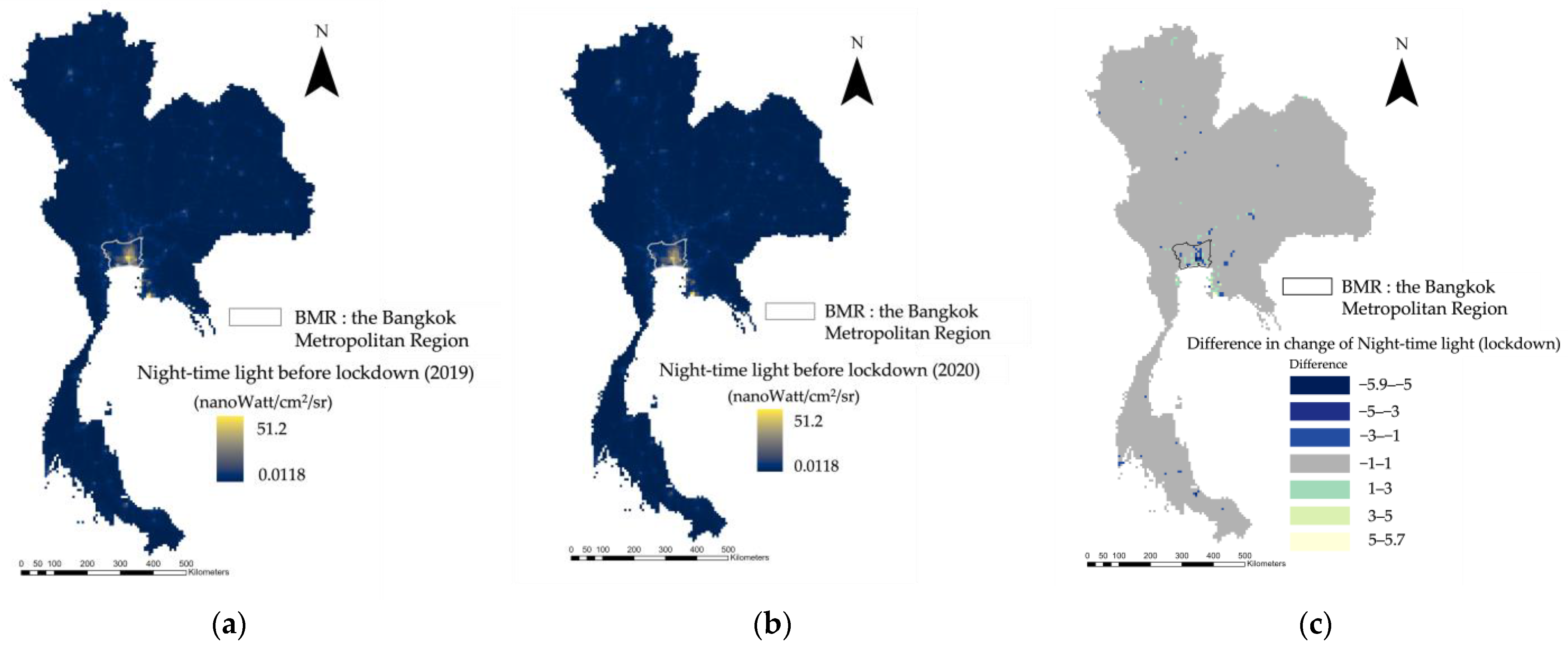
| Land Cover Types | Nighttime Light (Decreased) | NO2 (Decreased) | ||
|---|---|---|---|---|
| Count | Percentage (%) | Count | Percentage (%) | |
| Surface Water | 2 | 1.01 | 12 | 0.96 |
| Mangroves | 0 | 0 | 0 | 0 |
| Flooded Forest | 0 | 0 | 0 | 0 |
| Forest | 17 | 8.54 | 334 | 26.85 |
| Orchard or Plantation Forest | 35 | 17.59 | 62 | 4.98 |
| Evergreen Broadleaf | 8 | 4.02 | 69 | 5.55 |
| Mixed Forest | 16 | 8.04 | 251 | 20.18 |
| Urban and Built-Up | 63 | 31.66 | 96 | 7.72 |
| Cropland | 33 | 16.58 | 369 | 29.66 |
| Rice | 19 | 9.55 | 25 | 2.01 |
| Mining | 0 | 0 | 1 | 0.08 |
| Barren | 0 | 0 | 0 | 0 |
| Wetlands | 1 | 0.50 | 2 | 0.16 |
| Grassland | 1 | 0.50 | 15 | 1.21 |
| Shrubland | 0 | 0 | 2 | 0.16 |
| Aquaculture | 4 | 2.01 | 6 | 0.48 |
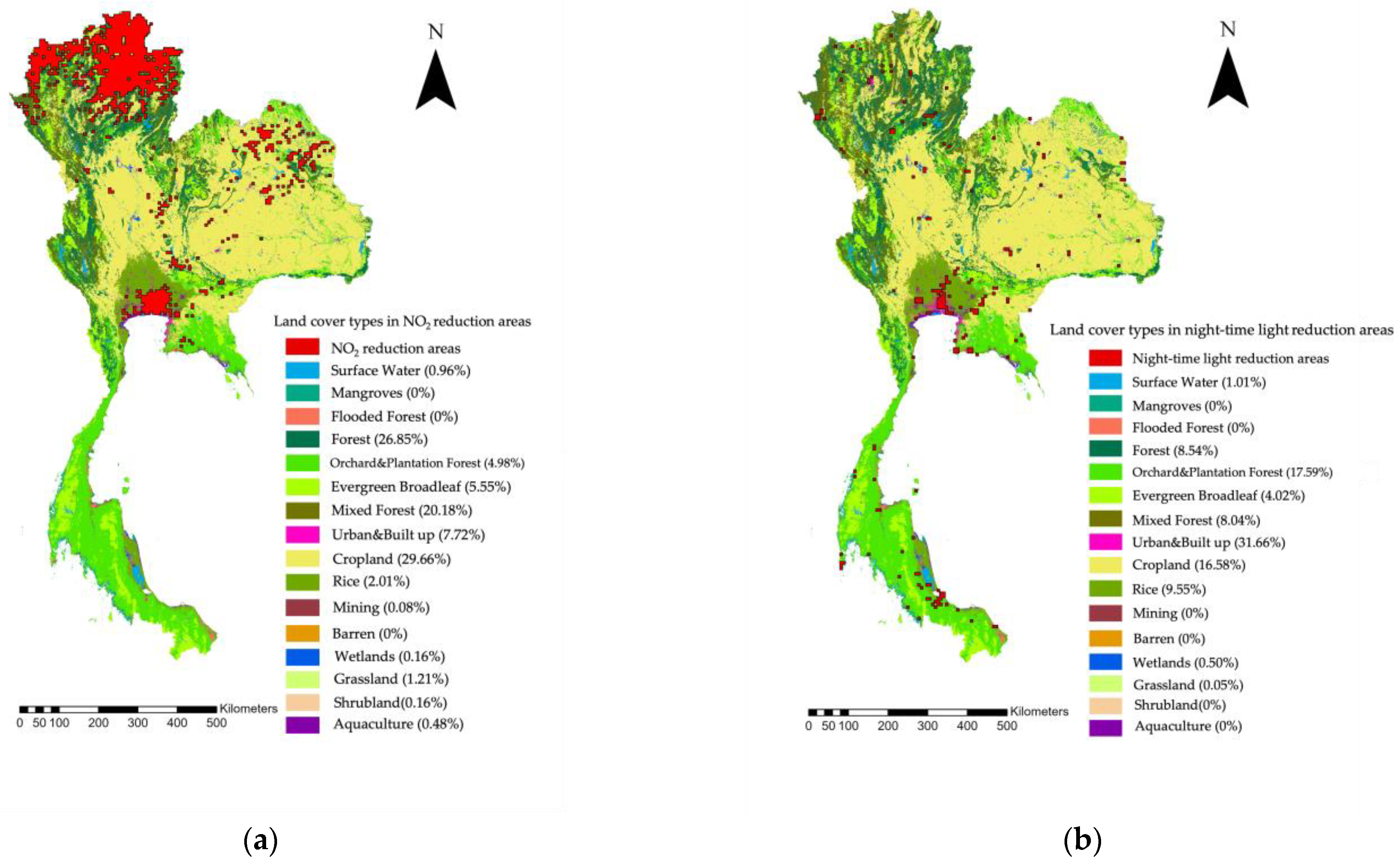
3.2. Association between the NTL and NO2 Levels
4. Discussion
5. Conclusions
Author Contributions
Funding
Data Availability Statement
Acknowledgments
Conflicts of Interest
References
- Cucinotta, D.; Vanelli, M. WHO declares COVID-19 a pandemic. Acta Biomed. Med. Atenei Parm. 2020, 91, 157. [Google Scholar] [CrossRef]
- WHO. WHO Coronavirus (COVID-19) Dashboard. 2020. Available online: https://covid19.who.int/ (accessed on 12 June 2021).
- Hong, S.H.; Hwang, H.; Park, M.H. Effect of COVID-19 non-pharmaceutical interventions and the implications for human rights. Int. J. Environ. Res. Public Health 2021, 18, 217. [Google Scholar] [CrossRef] [PubMed]
- Venter, Z.S.; Aunan, K.; Chowdhury, S.; Lelieveld, J. Air pollution declines during COVID-19 lockdowns mitigate the global health burden. Environ. Res. 2021, 192, 110403. [Google Scholar] [CrossRef]
- Patel, K. Airborne Nitrogen Dioxide Plummets Over China. Available online: https://www.earthobservatory.nasa.gov/images/146362/airborne-nitrogen-dioxide-plummets-over-china (accessed on 8 April 2021).
- Doi, H.; Osawa, T.; Tsutsumida, N. Assessing the potential repercussions of the COVID-19 pandemic on global SDG attainment. Disco. Sustain. 2022, 3, 1–11. [Google Scholar] [CrossRef] [PubMed]
- Kanniah, K.D.; Zaman, N.A.F.K.; Kaskaoutis, D.G.; Latif, M.T. COVID-19’s impact on the atmospheric environment in the Southeast Asia region. Sci. Total Environ. 2020, 736, 139658. [Google Scholar] [CrossRef] [PubMed]
- Roy, S.; Saha, M.; Dhar, B.; Pandit, S.; Nasrin, R. Geospatial analysis of COVID-19 lockdown effects on air quality in the South and Southeast Asian region. Sci. Total Environ. 2021, 756, 144009. [Google Scholar] [CrossRef] [PubMed]
- WHO. WHO Coronavirus (COVID-19) Thailand Situation Reports. 2020. Available online: https://www.who.int/docs/default-source/searo/thailand/2020-04-3-tha-sitrep-41-covid19-final.pdf?sfvrsn=9e14aebc_0.pdf (accessed on 15 August 2022).
- Jain, S.; Sharma, T. Social and travel lockdown impact considering coronavirus disease (COVID-19) on air quality in megacities of India: Present benefits, future challenges and way forward. Aerosol Air Qual. Res. 2020, 20, 1222–1236. [Google Scholar] [CrossRef]
- Pollution Control Department, 2021. State of Thailand Environmental Quality 2020. Available online: https://www.pcd.go.th/pcd_news/11873 (accessed on 8 November 2022). (In Thai).
- Kaewrat, J.; Janta, R.; Sichum, S.; Rattikansukha, C.; Tala, W.; Kanabkaew, T. Human Health Risks and Air Quality Changes Following Restrictions for the Control of the COVID-19 Pandemic in Thailand. Toxics 2022, 10, 520. [Google Scholar] [CrossRef]
- Doll, C.N.; Muller, J.P.; Morley, J.G. Mapping regional economic activity from night-time light satellite imagery. Ecol. Econ. 2006, 57, 75–92. [Google Scholar] [CrossRef]
- Kovács, K.D. Nighttime Light Emissions Explain the Decline in NO2 during a COVID-19-Induced Total Lockdown in France. Geogr. Tech. 2022, 17, 104–115. [Google Scholar] [CrossRef]
- Bustamante-Calabria, M.; Sánchez de Miguel, A.; Martín-Ruiz, S.; Ortiz, J.-L.; Vílchez, J.M.; Pelegrina, A.; García, A.; Zamorano, J.; Bennie, J.; Gaston, K.J. Effects of the COVID-19 Lockdown on Urban Light Emissions: Ground and Satellite Comparison. Remote Sens. 2021, 13, 258. [Google Scholar] [CrossRef]
- Xu, G.; Xiu, T.; Li, X.; Liang, X.; Jiao, L. Lockdown induced night-time light dynamics during the COVID-19 epidemic in global megacities. Int. J. Appl. Earth Obs. Geoinf. 2021, 102, 102421. [Google Scholar] [CrossRef] [PubMed]
- Shao, Z.; Tang, Y.; Huang, X.; Li, D. Monitoring work resumption of Wuhan in the COVID-19 epidemic using daily nighttime light. Photogramm. Eng. Remote Sens. 2021, 87, 195–204. [Google Scholar] [CrossRef]
- Zhao, X.; Yu, B.; Liu, Y.; Yao, S.; Lian, T.; Chen, L.; Wu, J. NPP-VIIRS DNB daily data in natural disaster assessment: Evidence from selected case studies. Remote Sens. 2018, 10, 1526. [Google Scholar] [CrossRef]
- Liu, Q.; Sha, D.; Liu, W.; Houser, P.; Zhang, L.; Hou, R.; Lan, H.; Flynn, C.; Lu, M.; Hu, T.; et al. Spatiotemporal Patterns of COVID-19 Impact on Human Activities and Environment in Mainland China Using Nighttime Light and Air Quality Data. Remote Sens. 2020, 12, 1576. [Google Scholar] [CrossRef]
- Jechow, A.; Hölker, F. Evidence That Reduced Air and Road Traffic Decreased Artificial Night-Time Skyglow during COVID-19 Lockdown in Berlin, Germany. Remote Sens. 2020, 12, 3412. [Google Scholar] [CrossRef]
- Stockholm Environment Institute. Air quality in Thailand. Available online: https://www.sei.org/wp-content/uploads/2021/02/210212c-killeen-archer-air-quality-in-thailand-wp-2101e-final.pdf (accessed on 12 January 2023).
- World Bank. Thailand—Environment Monitor 2002: Air Quality (English). Available online: http://documents.worldbank.org/curated/en/710411468778515943/Thailand-Environment-monitor-2002-air-quality (accessed on 12 January 2021).
- Veefkind, J.P.; Aben, I.; McMullan, K.; Förster, H.; De Vries, J.; Otter, G.; Claas, J.; Eskes, H.J.; De Haan, J.F.; Kleipool, Q.; et al. TROPOMI on the ESA Sentinel-5 Precursor: A GMES mission for global observations of the atmospheric composition for climate, air quality and ozone layer applications. Remote Sens. Environ. 2012, 120, 70–83. [Google Scholar] [CrossRef]
- Ialongo, I.; Virta, H.; Eskes, H.; Hovila, J.; Douros, J. Comparison of TROPOMI/Sentinel-5 Precursor NO2 observations with ground-based measurements in Helsinki. Atmos. Meas. Tech. 2020, 13, 205–218. [Google Scholar] [CrossRef]
- Liu, Z.; Ciais, P.; Deng, Z.; Lei, R.; Davis, S.J.; Feng, S.; Zheng, B.; Cui, D.; Dou, X.; Zhu, B.; et al. Near-real-time monitoring of global CO2 emissions reveals the effects of the COVID-19 pandemic. Nat. Comm. 2020, 11, 5172. [Google Scholar] [CrossRef]
- Van Der Velde, I.R.; Guido, R.; Van Der Werf, S.H.; Henk, J.; Eskes, J.; Pepijn Veefkind, T.B.; Ilse, A. Biomass burning combustion efficiency observed from space using measurements of CO and NO2 by the TROPOspheric Monitoring Instrument (TROPOMI). Atmos. Chem. Phys. 2021, 21, 597–616. [Google Scholar] [CrossRef]
- Elvidge, C.D.; Baugh, K.E.; Zhizhin, M.; Hsu, F.C. Why VIIRS data are superior to DMSP for mapping nighttime lights. Proc. Asia-Pac. Adv. Netw. 2013, 35, 62. [Google Scholar] [CrossRef]
- Murakami, D.; Tsutsumida, N.; Yoshida, T.; Nakaya, T.; Lu, B. Scalable GWR: A linear-time algorithm for large-scale geographically weighted regression with polynomial kernels. Ann. Am. Ass. Geog. 2020, 111, 459–480. [Google Scholar] [CrossRef]
- Lu, B.; Harris, P.; Charlton, M.; Brunsdon, C. The GWmodel R package: Further topics for exploring spatial heterogeneity using geographically weighted models. Geo-Spat. Inf. Sci. 2014, 17, 85–101. [Google Scholar] [CrossRef]
- Musikawong, S.; Jampaklay, A.; Khamkhom, N.; Tadee, R.; Kerdmongkol, A.; Buckles, L.; Khachasin, S.; Engblom, A. Working and Employment Conditions in the Agriculture Sector in Thailand: A Survey of Migrants Working on Thai Sugarcane, Rubber, Oil Palm and Maize Farms. International Labor Organization 2021. Available online: https://www.ilo.org/asia/publications/WCMS_844317/lang--en/index.htm (accessed on 20 March 2022).
- Yin, S.; Wang, X.; Zhang, X.; Guo, M.; Miura, M.; Xiao, Y. Influence of biomass burning on local air pollution in mainland Southeast Asia from 2001 to 2016. Environ. Pollut. 2019, 254, 112949. [Google Scholar] [CrossRef] [PubMed]
- Levy, I.; Mihele, C.; Lu, G.; Narayan, J.; Brook, J.R. Evaluating multipollutant exposure and urban air quality: Pollutant interrelationships, neighborhood variability, and nitrogen dioxide as a proxy pollutant. Environ. Health Perspect. 2014, 122, 65–72. [Google Scholar] [CrossRef]
- Pollution Control Department. Situation of Air Pollution in Decades on Thailand. 2000. Available online: http://www.pcd.go.th/public/Publications/print_report.cfm?task=report2543 (accessed on 30 August 2021).
- Greenpeace. Human Cost of Coal Power. 2015. Available online: https://www.greenpeace.or.th/Thailand-human-cost-of-coal-power/en.pdf (accessed on 15 February 2022).
- Menut, L.; Bessagnet, B.; Siour, G.; Mailler, S.; Pennel, R.; Cholakian, A. Impact of lockdown measures to combat COVID-19 on air quality over western Europe. Sci. Total Environ. 2020, 741, 140426. [Google Scholar] [CrossRef]
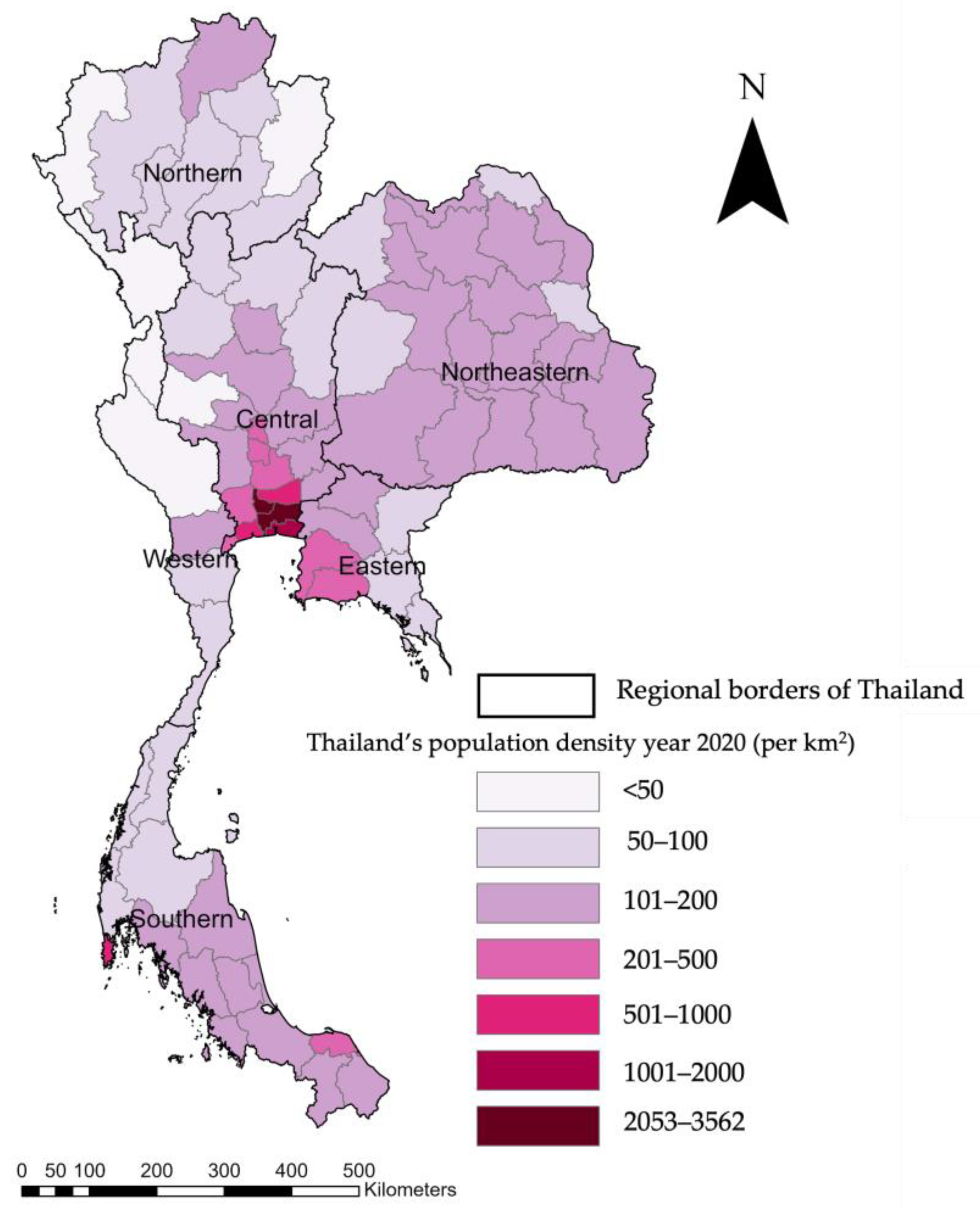
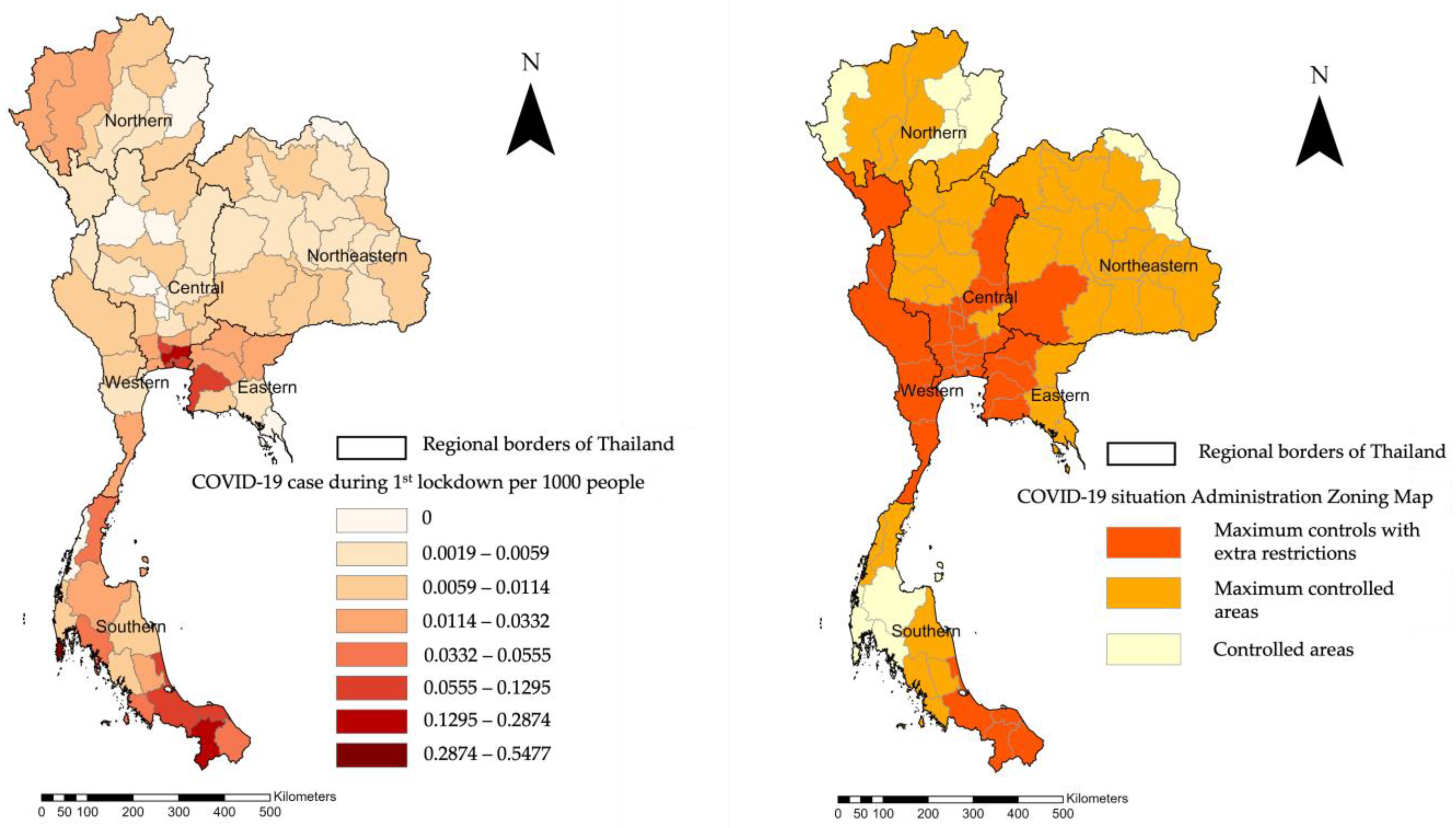
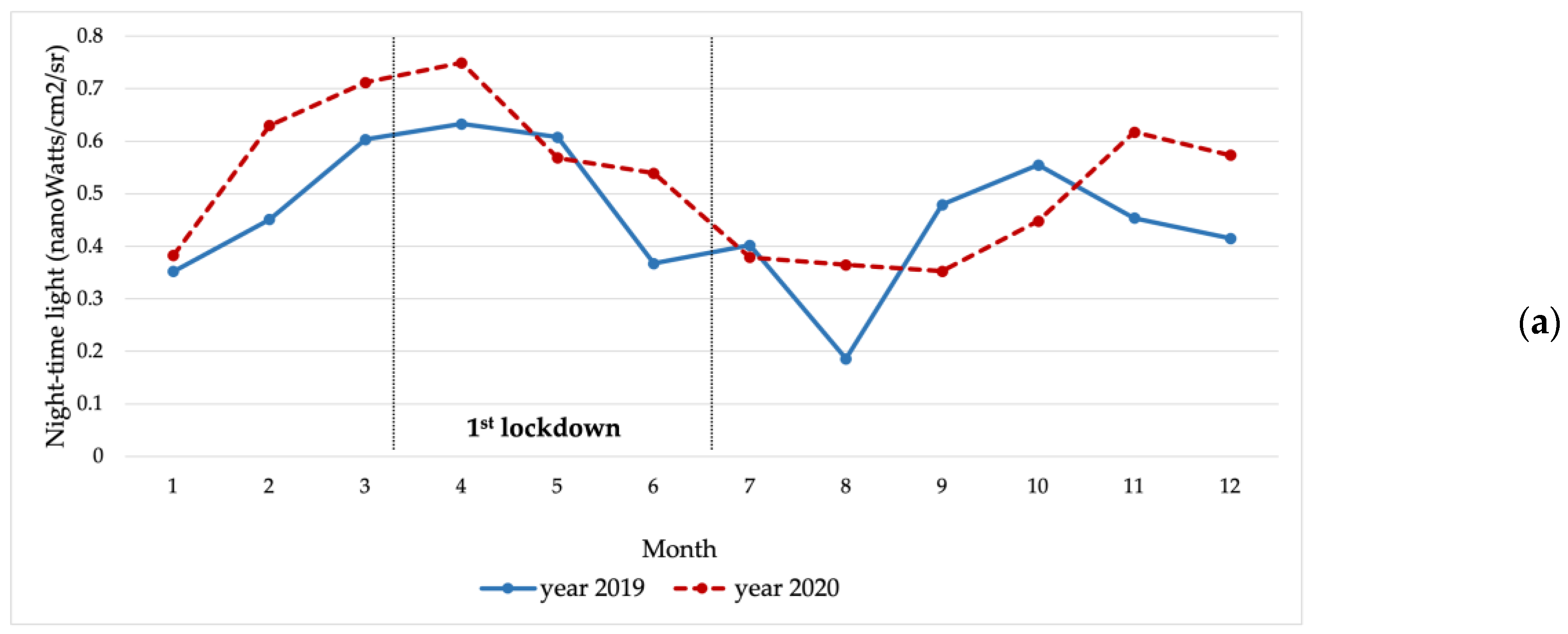

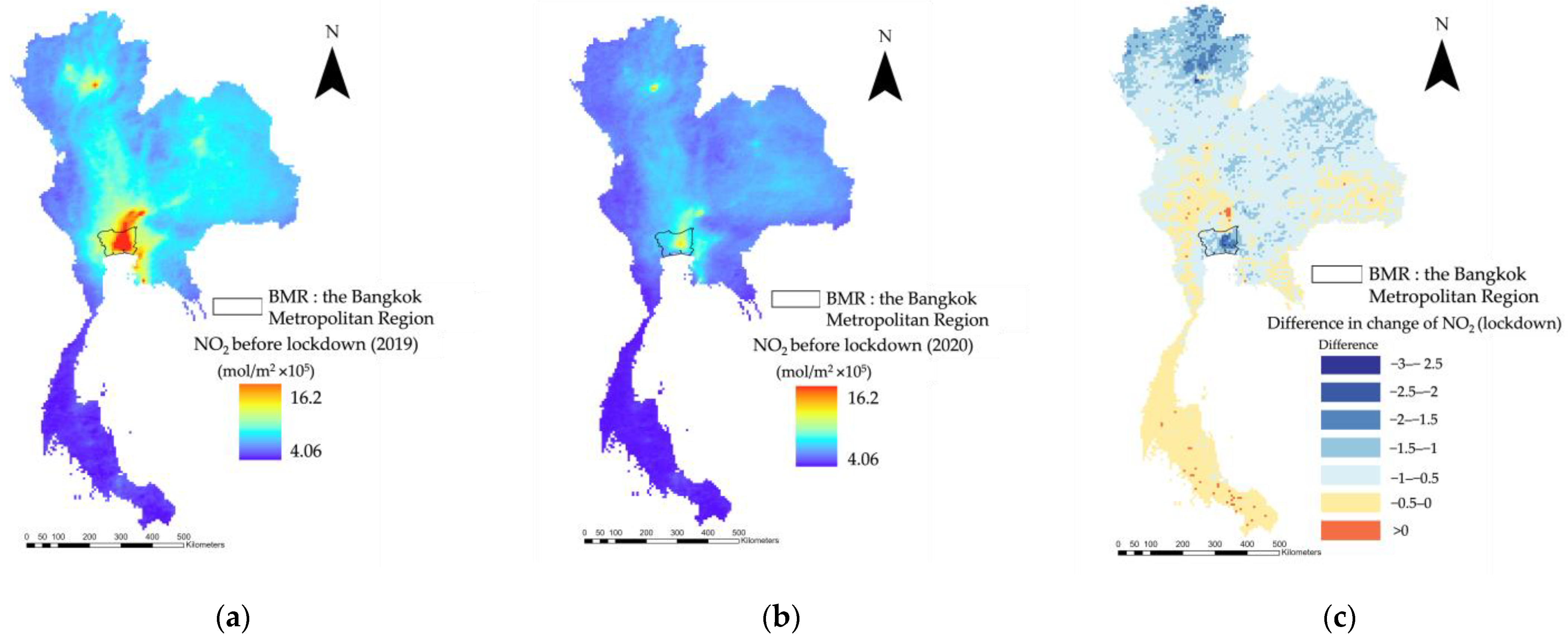
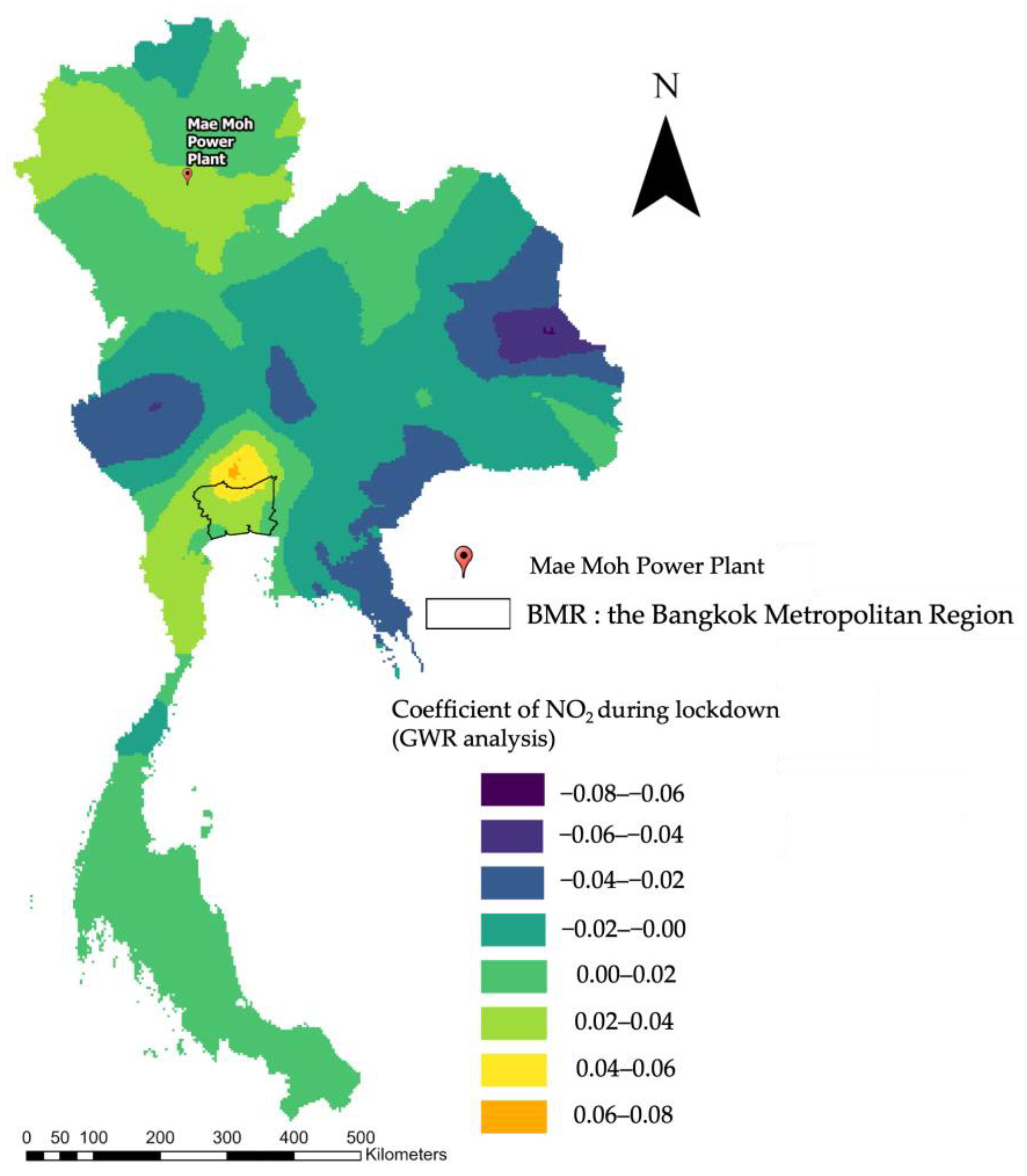
Disclaimer/Publisher’s Note: The statements, opinions and data contained in all publications are solely those of the individual author(s) and contributor(s) and not of MDPI and/or the editor(s). MDPI and/or the editor(s) disclaim responsibility for any injury to people or property resulting from any ideas, methods, instructions or products referred to in the content. |
© 2023 by the authors. Licensee MDPI, Basel, Switzerland. This article is an open access article distributed under the terms and conditions of the Creative Commons Attribution (CC BY) license (https://creativecommons.org/licenses/by/4.0/).
Share and Cite
Thongrueang, N.; Tsutsumida, N.; Nakaya, T. The Impact of Changes in Anthropogenic Activity Caused by COVID-19 Lockdown on Reducing Nitrogen Dioxide Levels in Thailand Using Nighttime Light Intensity. Sustainability 2023, 15, 4296. https://doi.org/10.3390/su15054296
Thongrueang N, Tsutsumida N, Nakaya T. The Impact of Changes in Anthropogenic Activity Caused by COVID-19 Lockdown on Reducing Nitrogen Dioxide Levels in Thailand Using Nighttime Light Intensity. Sustainability. 2023; 15(5):4296. https://doi.org/10.3390/su15054296
Chicago/Turabian StyleThongrueang, Nutnaree, Narumasa Tsutsumida, and Tomoki Nakaya. 2023. "The Impact of Changes in Anthropogenic Activity Caused by COVID-19 Lockdown on Reducing Nitrogen Dioxide Levels in Thailand Using Nighttime Light Intensity" Sustainability 15, no. 5: 4296. https://doi.org/10.3390/su15054296
APA StyleThongrueang, N., Tsutsumida, N., & Nakaya, T. (2023). The Impact of Changes in Anthropogenic Activity Caused by COVID-19 Lockdown on Reducing Nitrogen Dioxide Levels in Thailand Using Nighttime Light Intensity. Sustainability, 15(5), 4296. https://doi.org/10.3390/su15054296






